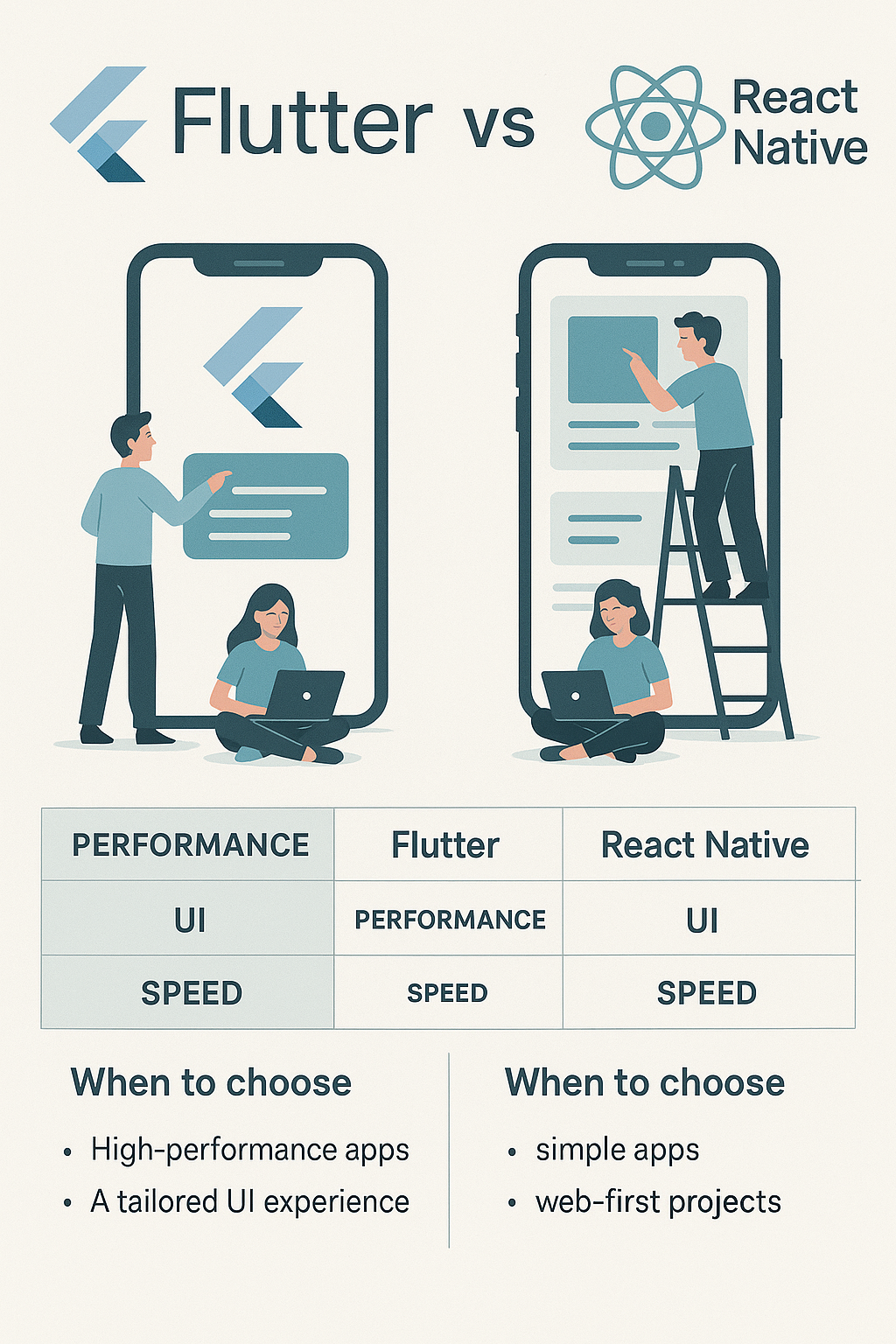Flutter vs React Native: Which Framework Should You Choose for Your App in 2025?
Flutter vs React Native: Which Framework Should You Choose for Your App in 2025?
Introduction Choosing the right cross-platform development framework is critical in building a mobile app that is scalable, performant, and future-ready. In 2025, two names continue to dominate the space: Flutter and React Native. Both offer impressive capabilities, vast communities, and strong corporate backing—but which is best for your project?

At TechDockLabs, we help CTOs, startups, and product teams navigate these decisions with precision. This guide offers an in-depth comparison of Flutter and React Native, helping you make an informed choice aligned with your goals.
1. Overview of Flutter and React Native Flutter, developed by Google, is a UI toolkit for building natively compiled applications from a single codebase using the Dart language.
React Native, backed by Meta (Facebook), enables developers to create apps using JavaScript and React, sharing components across Android and iOS.
2. Performance and Speed
- Flutter: Uses its own rendering engine and compiles to native code, which often leads to smoother performance and faster UI rendering.
- React Native: Relies on JavaScript bridges to interact with native modules, which can cause minor lag in high-performance apps unless optimized.
For graphically rich apps, animations, or games, Flutter typically delivers better frame rates and smoother transitions.
3. Development Speed and Productivity
- React Native: Offers fast iteration thanks to hot reloading and widespread JavaScript familiarity. Great for teams already using React on the web.
- Flutter: Hot reload is also available, but Dart is less common than JavaScript, requiring a slight learning curve.
If your team already knows JavaScript, React Native allows for quicker onboarding. However, Flutter’s unified architecture may speed up long-term development.
4. UI Design and Flexibility Flutter stands out with its widget-based UI system, allowing pixel-perfect design across platforms. It bypasses native UI components to deliver consistent interfaces regardless of the OS.
React Native depends on native components, which may vary slightly between Android and iOS—great for “native feel,” but trickier for consistency.
For design-heavy applications, Flutter gives greater control and faster implementation of custom UIs.
5. Community and Ecosystem
- React Native has a massive community, mature library ecosystem, and countless plugins.
- Flutter’s ecosystem is fast-growing, with solid support from Google and increasing enterprise adoption.
As of 2025, both ecosystems are strong, but React Native still edges ahead in terms of third-party library availability.
6. Integration Capabilities
- Flutter integrates seamlessly with Firebase, Google Cloud, and supports platform channels to bridge with native code.
- React Native excels in integrations with native modules and is ideal for adding mobile apps to existing web-based React projects.
Depending on your backend or cloud architecture, one may align better with your stack.
7. Maintenance and Scalability Flutter’s single codebase and well-documented architecture simplify long-term maintenance. Its widget-based approach reduces unexpected behaviors.
React Native projects can become complex due to dependency management and native module updates. Proper planning and CI/CD integration are key.
8. Enterprise Adoption in 2025 Major apps built with Flutter: Google Ads, Alibaba, BMW My App
Built with React Native: Instagram, Discord, Shopify Mobile
Enterprises continue to adopt both frameworks, with Flutter seeing rapid growth in finance, eCommerce, and healthcare due to its performance and UI control.
9. Cost Considerations Both Flutter and React Native reduce costs significantly compared to building separate native apps.
- Flutter may offer faster time-to-market due to fewer platform-specific customizations.
- React Native’s JavaScript base may reduce costs if you’re extending a web React project.
10. Which Framework Should You Choose? Choose Flutter if:
- You need pixel-perfect UI across platforms
- Your app demands rich animations and high performance
- You’re starting a new project from scratch
Choose React Native if:
- Your team already uses React/JavaScript
- You’re integrating with an existing React-based product
- You prioritize using mature third-party libraries
At TechDockLabs, we specialize in both frameworks and provide unbiased consultation to help you choose the right path. Check out our Cross-Platform App Development Services for more insights.
Conclusion In the Flutter vs React Native debate, there’s no one-size-fits-all winner. Both are excellent choices—but the best one depends on your team’s expertise, design priorities, and long-term product vision.
TechDockLabs helps you go from strategy to deployment with cross-platform excellence, ensuring your app is ready to lead in 2025 and beyond.

